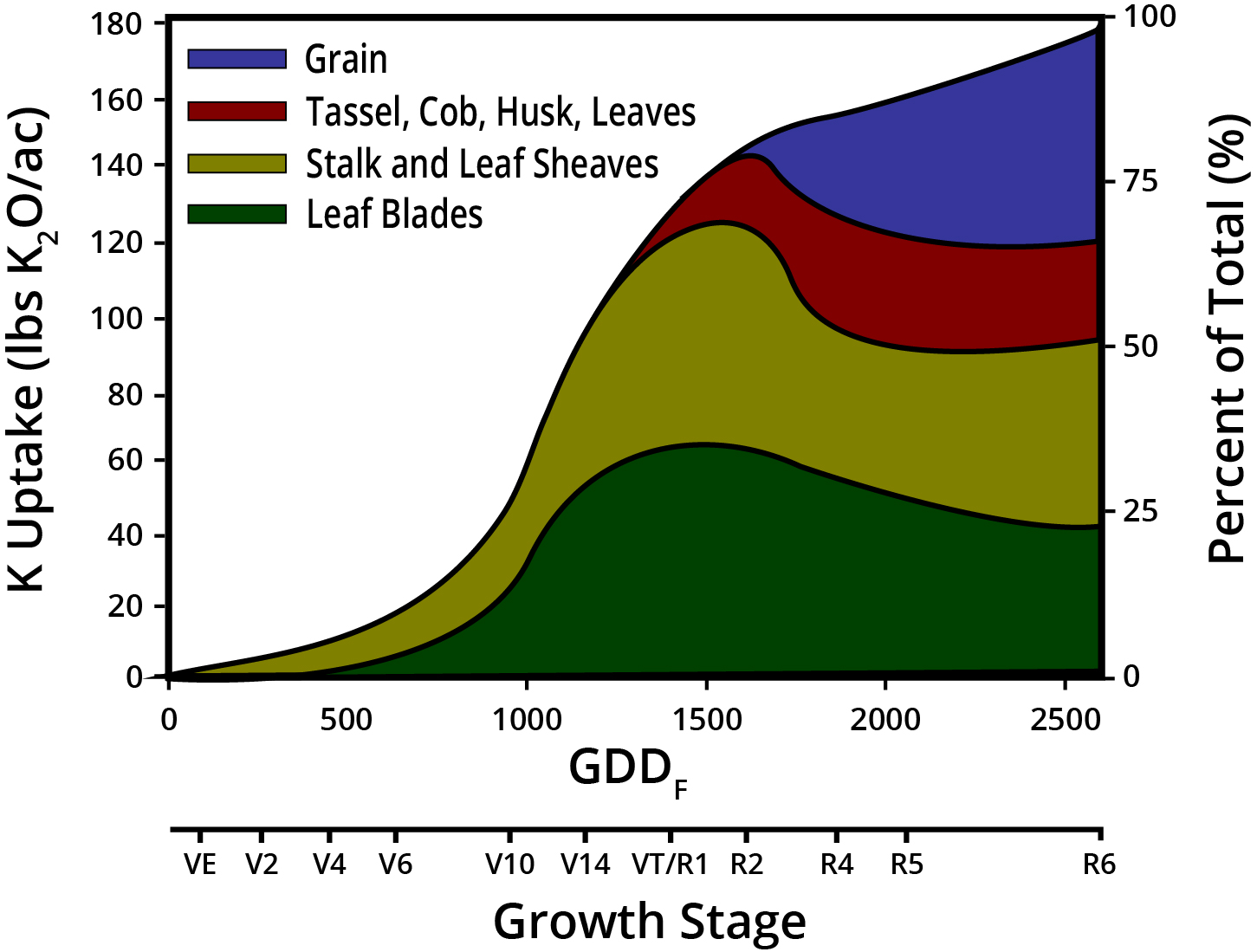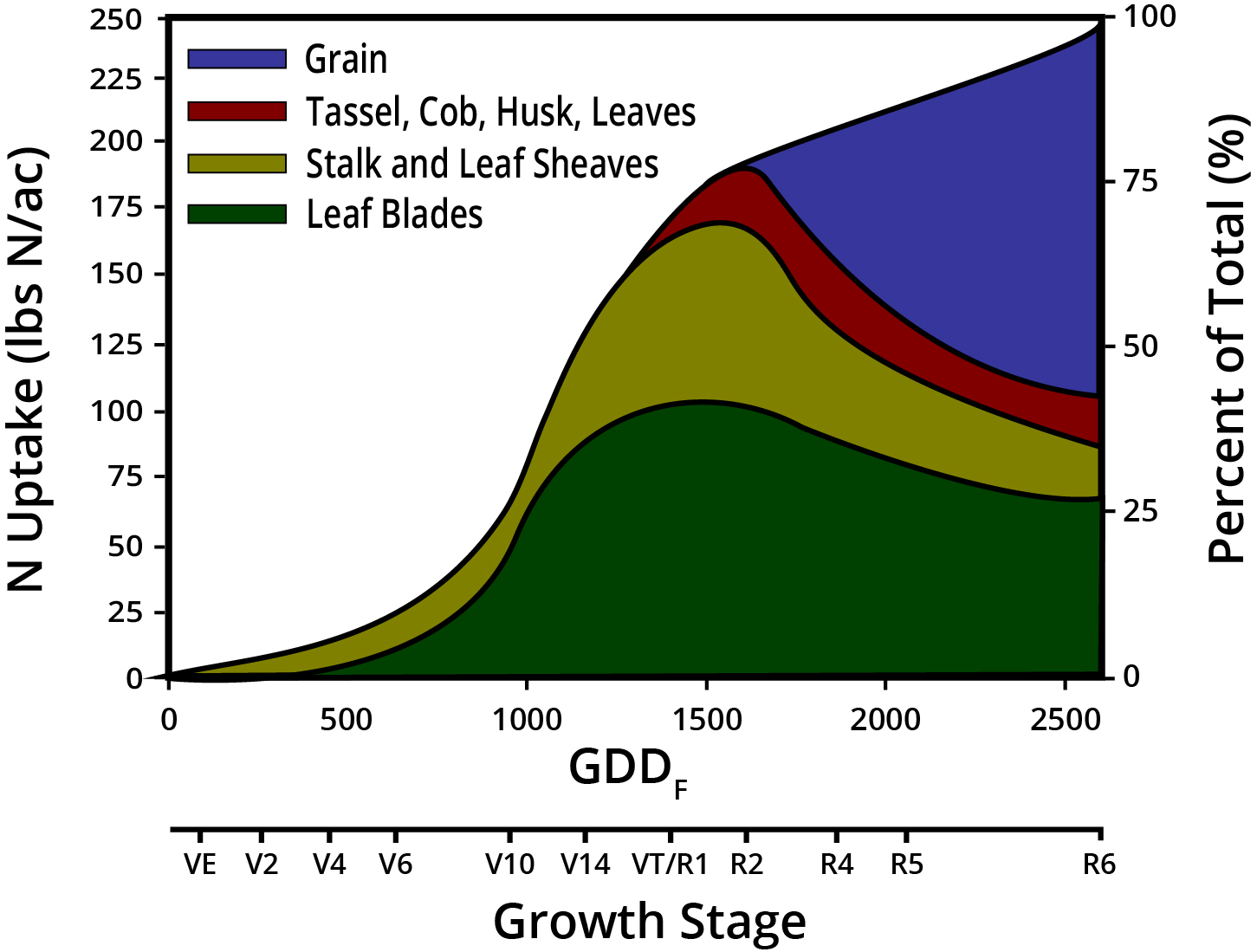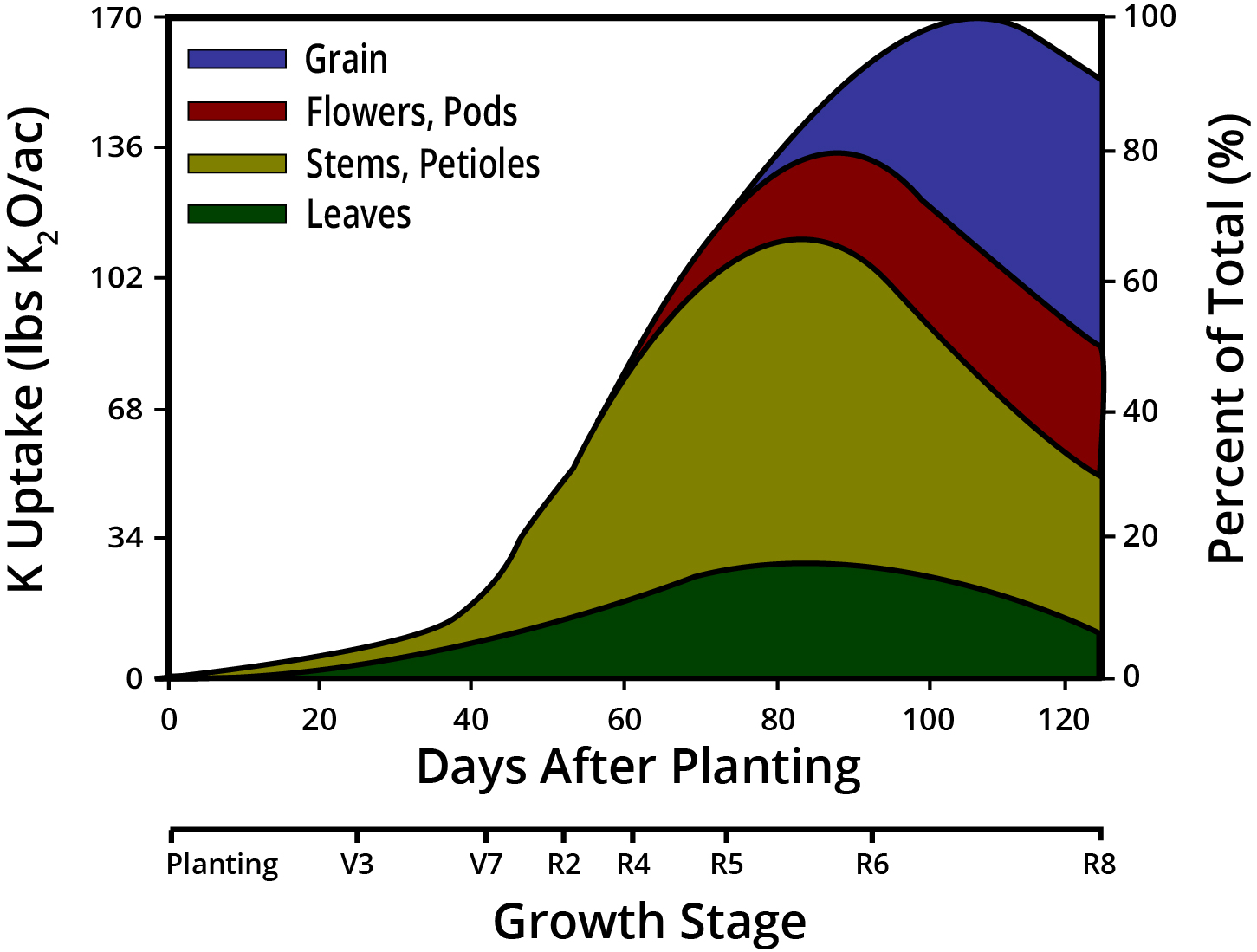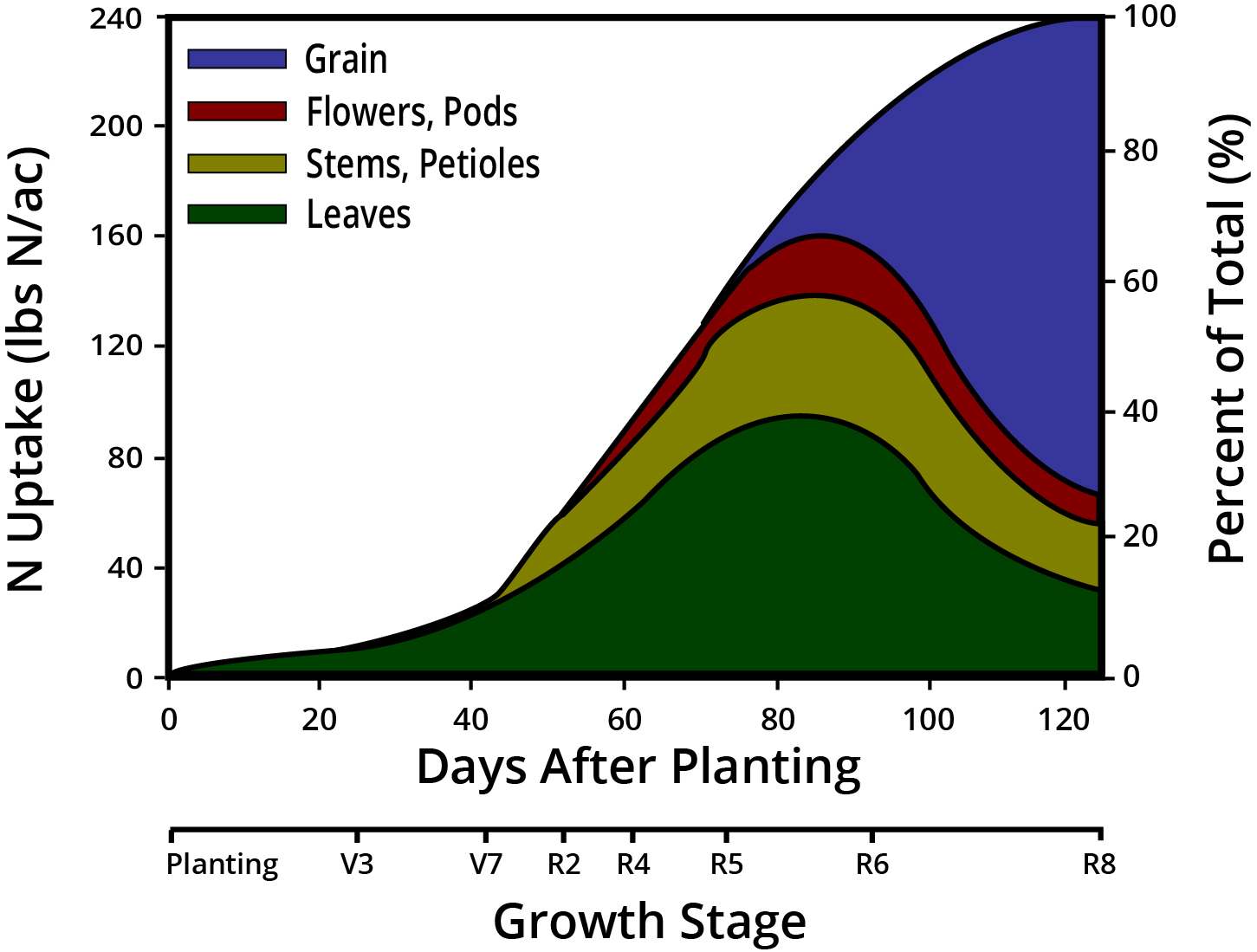The Importance of Potassium to Plant Growth
Potassium is essential for optimal growth. It performs a number of functions that ensure healthy, stress-tolerant plants. Vital in regulating water, K helps to create concentration gradients inside the plant and, in turn, supports water uptake into the plant, which is essential in times when water is not readily available (Marschner, 2012). In addition, K regulates the plants’ leaf tissue openings (i.e., stomata) to keep moisture in the plant, thus reducing water loss through the leaves and helping to maintain stalk strength and standability. Potassium activates over 80 enzymes that regulate plant growth reactions, which helps prevent disease and control insects. Additionally, adequate K increases winter hardiness in crops such as alfalfa. Potassium exists in the soil solution as K+, which has a positive charge and is readily available for plant uptake. The K+ ion plays a critical role in efficient N use by balancing the negative charge of nitrate (NO3 -) as roots take up NO3 – and distribute it throughout the plant (i.e., long-distance transport in the xylem) (Marschner, 2012).
Potassium and Nitrogen Uptake
Potassium is second to N in terms of quantity that both corn and soybean plants need. A 230 bu/ac corn crop requires an average of approximately 180 lbs K2O/ac and 256 lbs N/ac (Bender et al, 2013), while a 60 bu/ac soybean crop requires an average of approximately 170 lbs K2O/ac and 245 lbs N/ac (Bender et al., 2015). Peak uptake rates for both K and N occur between V8-VT in corn and V6-R5 in soybean. In modern corn hybrids and soybean varieties, K and N uptake occur simultaneously, with up to 2/3rds of the total amount taken up by the beginning of grain-fill and primarily during vegetative and early reproductive growth (Figure 1, Figure 2).
FIGURE 1: Total K (top) and N (bottom) uptake and partitioning in corn yielding 230 bu/ac (Bender et al., 2013).


FIGURE 2: Total K (top) and N (bottom) uptake and partitioning in soybean yielding 60 bu/ac (Bender et al., 2015).


Potassium and Nitrogen Use Efficiency
Field studies have documented the role of K in N use efficiency. In Wisconsin, Jones et al. (2022) assessed corn yield response to different N rates under low, optimum, and high soil-test phosphorus (P) and K. When soil-test P and K were deficient, corn yield did not increase with increasing N rates (Figure 3). However, when soil-test P and K were optimum, corn yield increased up to 55 bu/ac with increasing N rates. These results highlight the synergy between K and N nutrition and that optimum soil-K levels are required to optimize N use efficiency.
While N applications in soybean have been on the rise, they are not routine as soybeans obtain the majority of N through biological nitrogen fixation. Rhizobium bacteria form a symbiotic relationship with soybeans, and in exchange for carbohydrates (carbon), convert atmospheric N gas (N2) into a plant-available form of N. Adequate soil-K levels influence N use efficiency in soybean by activating the nitrogenase enzyme, which is essential for N2 fixation, and by aiding in carbohydrate transport to the roots (Imas and Magen, 2008). Additionally, K influences a plant’s photosynthetic capacity, especially during drought conditions, which indirectly influences the amount of carbohydrates supplied to rhizobia for N fixation. Soybeans grown with adequate K may have better nodule formation, leading to higher N fixation and N use efficiency.
As government regulations are imposed and Ecosystem markets expand, the need to improve N use efficiency will become critical. Balancing N and K is one of the most cost-effective ways to meet this need because adequate K and N availability improves N uptake and the conversion of N into plant dry matter. Increasing N uptake and fertilizer recovery with adequate K nutrition may reduce the potential for N losses to the environment (e.g., N2O).
Soil Test Trends Across North America
Soil tests provide information on nutrient levels, and when analyzed for trends over time, give an indication of a soil’s relative capacity to provide adequate nutrients for plant growth.
A summary of soil tests taken throughout North America in 2020 showed that 44% of soils were below the critical level of which soil K levels should be maintained at to minimize yield loss (TFI, 2021). Yield trends continue to increase for major field crops, resulting in greater K removal and declining soil nutrient levels in areas such as the Midwest, Eastern Corn Belt, and Southeast U.S. (Figure 4). These data indicate K is a yield-limiting factor in a large portion of soils across North America.
Additionally, some corn hybrids require higher K and/or higher N uptake per bushel of grain, which may be an additional factor contributing to declining soil K values. Working closely with the seed provider helps agronomists and growers understand these needs before deficiency symptoms appear and yield potential is limited.
While maintaining optimum soil-K levels is often the goal, in dry environments or when soil moisture shortages are likely, it is often desirable to raise soil-K levels to the high category to help K, and likely N, move from the moisture-limited soil into the plant.
Current soil test data and trends emphasize the need to include K as part of balanced crop nutrition approach to optimize yield and nutrient use efficiency.

FIGURE 3: The percent of samples testing below the critical level for K in North America (TFI, 2021). Colors of each state or province indicate the change in samples testing below critical levels (CL) from 2015 to 2020.
Conclusion/Implications
Balanced crop nutrition (i.e., applying nutrients in a ratio that matches crop demands) is one of the most effective ways to maximize fertilizer use efficiency. Because of the critical role K plays in stomatal regulation, water use efficiency, disease tolerance, and N uptake, growers should evaluate soil-K levels before reducing or eliminating K applications from a crop nutrition program. Ensuring soil-K levels are adequate and crop K removal is provided annually with products such as Aspire® (0-0-58-0.5B) may help growers optimize N use efficiency and their fertilizer investment.
References:
Marschner, P. 2012. Marschner’s Mineral Nutrition of Higher Plants. 3rd ed., Academic Press, San Diego, USA.
Bender, R.R., Haegele, J.W., Ruffo, M.L., and Below, F.E. 2013. Modern corn hybrids’ nutrient uptake patterns. Better Crops with Plant Food. 97:7-10.
Bender, R.R., Haegele, J.W., and Below, F.E. 2015. Modern soybean varieties’ nutrient uptake patterns. Better Crops with Plant Food. 99:7-10.
Jones, J.D., Laboski, C.A., and Arriaga, F.J. 2022. Improved Phosphorus and Potassium Management. 2022 Badger Crops and Soils Update Meeting. Univ. Wisconsin-Madison.
Imas, P. and Magen, H. 2008. Role of potassium nutrition in balanced fertilization for soybean yield and quality – Global Perspective. International Potash Institute.
TFI. 2021. Soil Test Levels in North America, 2020 Summary Update. The Fertilizer Institute, Arlington, VA 22203, USA.